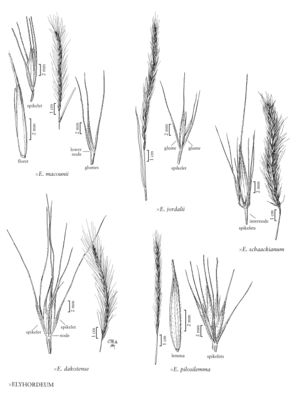Difference between revisions of "×elyhordeum pilosilemma"
FNA>Volume Importer |
FNA>Volume Importer |
||
| Line 19: | Line 19: | ||
-->{{Treatment/Body | -->{{Treatment/Body | ||
|distribution=Alaska | |distribution=Alaska | ||
| − | |discussion=<p>×Elyhordeum pilosilemma is a hybrid between | + | |discussion=<p>×Elyhordeum pilosilemma is a hybrid between Elymus macrourus and Hordeum jubatum that occurs in many locations where the two parental species co-occur. It is very similar to ×E. jordalii, a hybrid between E. macrourus and H. brachyantherum.</p> |
|tables= | |tables= | ||
|references= | |references= | ||
| Line 35: | Line 35: | ||
|basionyms= | |basionyms= | ||
|family=Poaceae | |family=Poaceae | ||
| + | |illustrator=Cindy Roché and Annaliese Miller | ||
|distribution=Alaska | |distribution=Alaska | ||
|reference=None | |reference=None | ||
| Line 40: | Line 41: | ||
|publication year= | |publication year= | ||
|special status= | |special status= | ||
| − | |source xml=https:// | + | |source xml=https://bibilujan@bitbucket.org/aafc-mbb/fna-data-curation.git/src/314eb390f968962f596ae85f506b4b3db8683b1b/coarse_grained_fna_xml/V24/V24_407.xml |
|subfamily=Poaceae subfam. Pooideae | |subfamily=Poaceae subfam. Pooideae | ||
|tribe=Poaceae tribe Triticeae | |tribe=Poaceae tribe Triticeae | ||
Revision as of 16:07, 30 October 2019
Culms 40-75 cm, erect, glabrous. Sheaths glabrous or pubescent; blades 6-15 cm long, 2-4 mm wide, flat, adaxial surfaces glabrous or hairy. Spikes 6-12 cm long, 5-7 mm wide including the awns, erect to arching, with 1-2 spikelets per node; internodes 2-5 mm, concealed by the spikelets. Spikelets 7-13 mm, with 2-3 florets and 2-3 glumes. Glumes 10-18 mm including the awns, not indurate at the base, linear to linear-lanceolate, hispid, 1-3-veined; lemmas 7-10 mm, evenly pilose, hairs about 0.2 mm, awns as long as to slightly longer than the lemma bodies; anthers 1-1.5 mm, indehiscent. In = 28.
Discussion
×Elyhordeum pilosilemma is a hybrid between Elymus macrourus and Hordeum jubatum that occurs in many locations where the two parental species co-occur. It is very similar to ×E. jordalii, a hybrid between E. macrourus and H. brachyantherum.
Selected References
None.
